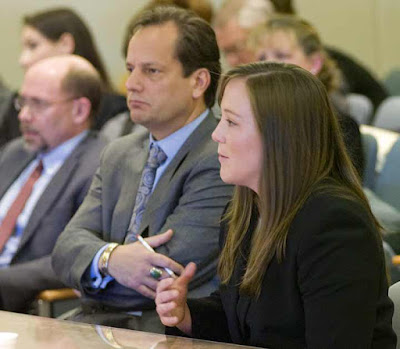After more than a year’s delay State Senator Linda Lopez, D - Bernallillo County, convened the Senate Rules Committee and preceded confirmation hearing on Governor Bill Richardson’s
of University of New Mexico Board of Regents James “Jamie” Koch.
The Senate Rules Committee held confirmation hearings of two regents appointed within the last year: Student Regent Emily Caitlyn Wisdom, above, sponsored by Sen. John Ryan R - Bernalillo County, and Regent J.E. “Gene” Gallegos, who were
in May of 2009.
Koch’s hearing stirred a major debate with a large contingent of UNM faculty, staff, students, and alumni who signed in to speak against his reappointment; there were two who singed up to speak in support.
Koch took the opportunity to address criticism by saying that this was the first time he had publicly been allowed to defend himself.
Koch admitted that there were 30 outstanding audits. Koch, center, with sponsor, Sen. Peter Wirth, D - Santa Fe; Albuquerque Journal Staff Writer Martin Salazar is to the right. Salazar established himself as a UNM Administration beat reporter with very good sources when he was a staff reporter at the UNM Daily Lobo a few years ago.
.
of no confidence almost a year ago, they allowed President David Schmidly to speak in his own defense, but not Koch or Executive Vice President David Harris, whose names were also on the ballot.
Koch complained in a post event press release that appeared to be a prepared speech, not given.
Of the 492 total votes cast on the question of no confidence in then Regents President Koch, 482 votes were for “no confidence,” seven votes were against, and there were three abstentions.
that was involved with contracting for an independent auditor to conduct the survey the Faculty Senate
of selected areas of the University budget where cuts have been made to academic programs. The contract is expected to be let in April and the audit done before summer, according to Gallegos.
The Realtors Association of New Mexico Secretary M. Steven
, the former U.S. Department of Agriculture New Mexico State Rural Development Coordinator spoke in favor of Koch. Anaya is the nephew of former Democratic Governor, Toney Anaya, who made Steven a political appointee to be New Mexico State Fair director.
Anaya, below left panel, said he knew Koch when Anaya had been a Regent at New Mexico State University and they had a cooperative relationship. Anaya sat on the UNM Hospital Board, two years as its president, said Koch had been instrumental in getting the new “Bill and Barbara,” wing built.
Seated to the left of Anaya, is former State Senator and Bernalillo County Commissioner Les Houston. Houston had changed party when he was in the Senate from Democrat to Republican and went on to become Senate Minority Leader.
UNM Cancer Center Director Dr. Cheryl Willman, above right, spoke in favor. “Jamie Koch’s, Regent Koch’s support has been absolutely phenomenal in hiring,” staff, Willman said.
She said there were over 800 staff members of the Schools of Medicine, Pharmacy, and Nursing and the vast majority stood in favor of Regent Koch.
Former Governor of the Cochiti Pueblo Regis Pecos, below left, who was a member of the Board of Trustees at
University, and now works for House Speaker Ben Lujan, also spoke in favor, saying Koch was the most accessible regent. He commended Koch with having convened the first ever summit with tribal leaders to address issues important to Native American students.
Former State Senator, serving District 37, from 1971-72, and District Court Judge Bob
, said he had known Koch for 40 years and had served in the Senate while Koch served in the House.
Former Associated Students UNM President Kevin Grant Stevenson, now Program Planning Manager, working for Vice President for Research and Economic Development Julia Fulghum, Ph.D., said that when he was in the Student Senate, Koch was the first non-student regent to approach student government. He attributed Koch’s efforts in creating a student’s section for Lobo Basketball at the Pit.
“James H. Koch receives an F based on my evaluation,” said UNM Regents’ Lecturer and Biology Professor Dr. Tim Lowery, below left, who provided a six-point evaluation of how well UNM has faired under six years of Koch being a regent.
University Honors Program Associate Professor Ursula Shepherd, above right, is the Faculty Governance Committee Chair. She spoke about the Koch no confidence vote of 492-7 taken a year ago which contends represented a schism between the Medical school and the main campus. She asked for the faculty that had come to speak, but didn’t, to stand.
The Immediate Past President of the Staff Council Loyola Chastain, below left, just retired as a staff employee at the Anderson School of Management said the Koch had no leadership abilities. She accused Koch of allowing a hostile work environment by letting other regents berate and bully faculty members who called for the following of established policies in administrative pay raises. She pointed out that David Harris was hired on a sole source hire for $140,000 without a search process freezing out long time university workers who might have been qualified for the position.
“In my most humble opinion regents in this day and age are selected simply to pay back political favors for elected officials, in this case, the governor,” Chastain said. “There was a time when regents were selected not for who they knew or who they helped get elected, but for what they knew.”
“Executive pay has risen 71 percent, faculty has decreased while enrollment has grown, athletic facilities have improved while educational facilities have remained in a state of disrepair or fallen off the radar and a hostile work environment has been created for faculty and staff,” Chastain said.
UNM Department of Physics and Astronomy Assistant Professor and President of the Faculty Senate Douglas Fields, above right, said, there was another vote of no confidence a week earlier and the faculty asked Governor Richardson to withdraw the Koch reappointment.
He further objected to regent Koch’s action on audit committee. "He is not the right man for the job,” Fields said.
Regents' Professor in Biology Margaret Werner-Washburne, above, objected, in part, because people had told her the Koch reconfirmation was a, “done deal.” She complained that the regents were concerned about professional degrees at the expense of, “the heart of the institution is Arts and Sciences.”
"There are two kinds of people; common people and then the people of power and privilege and that you really don’t care much about what we think," Ched MacQuigg said speaking out against Koch's reappointment. "I heard a Senator say this morning he intended to vote in favor of this confirmation before the testimony even started."
Graduate Student and Graduate Professional Student Association American Studies Council Representative Desi Brown, below left, said that for the past six and a half years he had not met a single person who thought Koch was looking out for the core purpose of the University and the supporters of that mission.
Graduate/Professional Students Association President Lissa Knudsen, above right, said that in the preceding week the GPSA in an unprecedented vote, “over 85 percent wants to reprioritize fees from athletics to programs more aligned with the University’s mission,” Knudsen said. “Koch has misstated that athletics makes money.”
The discussion then shifted to committee members.
State Senate Majority Leader Michael Sanchez, D - Valencia County, defended his earlier statement that he was going to vote for all the governor's regent appointments before listening to testimony at the committee hearing. "I have gotten hundreds of emails form these same people," Sanchez said, pointing to the audience of UNM faculty and staff members, taking on MacQuigg's comments. "But nothing that has been said here today changes my opinion from all of the things I’ve read, all of the things I’ve heard, and all of the things I’ve seen."
Sanchez made no other statement detailing why he supported Koch.
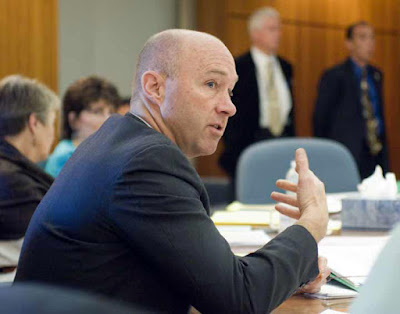
“Just to echo what Sen. Sanchez said, you see articles in the paper indicating that the fix is in,” Ranking Rules Committee Member Sen. Kent Cravens, above, R – Bernalillo County, said, “I wasn’t contacted by anybody in anyway about my vote on this particular confirmation.” “And the reason it’s so important to come to this committee and sit through the whole committee and listen to all the testimony, is so you can hear both sides of the issue,” Cravens said. “You can hear testimony that totally flips your world around.”
"The truth is somewhere between as bad as it gets and as good as you hope,” Cravens said. “The fix is never in on these votes.”
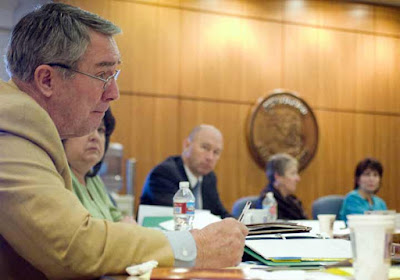
Minority Senate Floor leader Stuart Ingle, above left, R - Chaves, Curry, De Baca and Roosevelt Counties, complained about how the executive salaries had increased 30 percent in ten years and how there is the use of golden parachutes.
“Every aspect of state government needs an audit,” Ingle said.
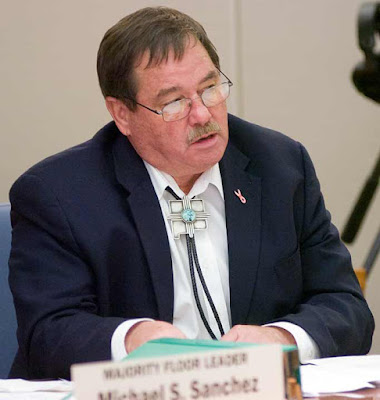
Seven out of eight of the most recent regents have come from the Albuquerque – Santa Fe area with the other regent coming from Farmington, Senate President Pro Tempore Timothy Jennings, D - Chaves, Eddy, Lincoln, and Otero Counties, said. “I got a ton of mail and emails from a lot of people, and it certainly opened my eyes about a lot of things.”
“Should the professors or graduate students run the university,” Jennings asked? “My answer is no they shouldn’t.”
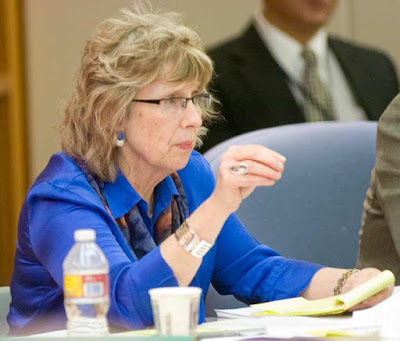
Sen. Dede Feldman, D – Bernalillo County, who was an UNM adjunct instructor, pointed out there is a 44 percent drop out rate of students.
Another complaint was that the instructor-student ratio was over 20 to 1 in 2008, which is now more than a 28 percent increase in class size in ten years.
Koch, in response to a question from Feldman about where the audit was, said that he was glad to talk about it. He said that newly appointed Regent Gene Gallegos was the chair of the audit committee and it was recently decided that the State Auditor would conduct the audit, like the faculty wanted.
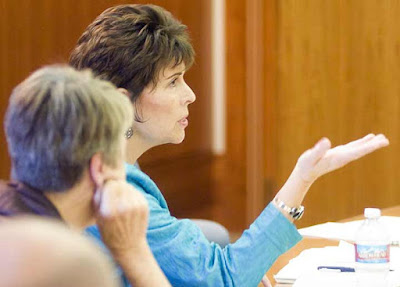
Senate Rules Committee Chair Sen. Lopez announced that their five-hour hearing between the Transportation and Regent’s confirmations set a record for length.
“Twenty-seven years ago I attended the University of New Mexico,” Lopez said, “I wish that the attitude I hear today was prevalent 27-years ago, when I was at the college of fine arts and sciences, in front of a counselor. But I was told, my type of people don’t need to be there. I needed to go on and find a job.”
My constituents want to see their children succeed, Lopez said. “Where the Hell is it?”
The Senate Rules Committee confirmed Koch on a 7 – 1 vote with Sen. Feldman against.

During the earlier debate on Regent Gene Gallegos, and after several negative comments from the public, Sen. Sanchez said, that he was going to vote for Gallegos and the others who were up for confirmation. His statement was made before any public comments were taken on Koch’s reconfirmation.
If such a statement was made during Sanchez’ day job – criminal defense attorney – by a juror, he would yell bloody murder, demand a mistrial and rightfully get one; it’s called prejudicial.
When a couple of audience members said that they had heard, “the fix was in,” Sanchez bristled at the suggestion. However, the timing of the earlier statement proves the point. The concern that the “fix is in” has resonated in the university community for a while as illustrated in a recent
Daily Lobo article.
Sanchez, has been a New Mexico State Senator since 1992, but did not disclose a number of facts that some see as conflicts of interest.
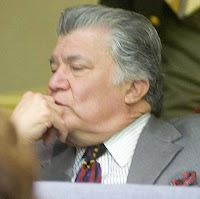
His brother and former Speaker of the House Rep. Raymond Sanchez, right, D - Bernalillo County, is the current
President of UNM’s Board of Regents, having
replaced Koch after Richardson demanded a shuffle within the past year.
Michael Sanchez is a 1973 graduate of the University of New Mexico School with a Bachelor of Arts degree and in 1976
acquired a Juris Doctor, from UNM Law School.
Michael Sanchez' daughter, Katrina Laura Marissa Sanchez, is a Student Technical Specialist with the University Communication and Marketing Department. She is a fourth-year senior, with a declared major in Political Science seeking of Bachelors of Arts through the College of Arts and Sciences.

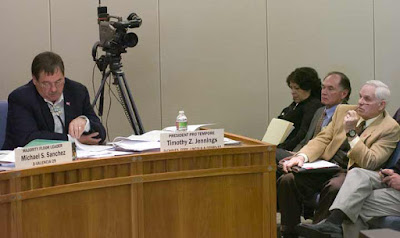
During Regent Wisdom's hearing, Jennings, left, gave one of his meandering and winded explanations, for which he is infamous, about why he doesn’t like UNM. He went into great detail about his daughter’s inability to be accepted because of who her parents were and how she went to a Texas school and performed exceptionally well.
He blasted the school for allowing the student newspaper, the Daily Lobo, to run an article about anal sex. That sent him off into a tirade about a 41-year old event, the optional reading assignment by an English Department teaching assistant of Lenore Kande’s "Love-Lust Poem."
Santa Fe New Mexican’s Political Reporter Steve Terrell tells the
story well.

On the Senate floor several Senators referred to Koch as a friend or good friend, yet pronounced his name several different ways. Koch pronounces his name Cook.
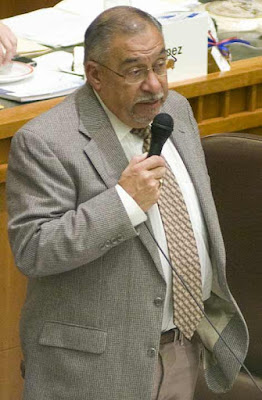
Sen. Phil Griego, above, D – Los Alamos, Mora, Sandoval, San Miguel, Santa Fe, and Taos Counties, mispronounced Koch’s name, but called him a friend and supported his reappointment.

Sen. Sue Wilson Beffort, R - Bernalillo, Sandoval, Santa Fe, and Torrance Counties, spoke in favor of Koch recounting, in part, his athletic abilities and then said he was, “a buff and handsome man sitting up there,” on the dais.
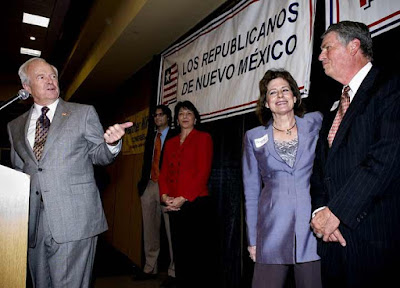
She did not reveal her direct personal conflict of interest. Her husband, UNM Vice President of Institutional Support Services Steven Beffort, earns $193,800.00 a year. Beffort, above right, with wife, Sue Wilson Beffort, during the 2004 Republican gubernatorial contender John Dendhal’s concession speech to the reelection of Gov. Bill Richardson. Wilson Beffort was the GOP Lt. Gov. candidate.
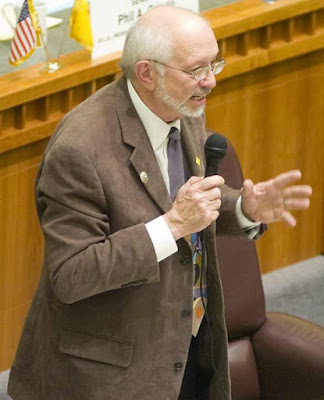
Sen. Gerald Ortiz y Pino, above, D – Bernalillo County, spoke against Koch.
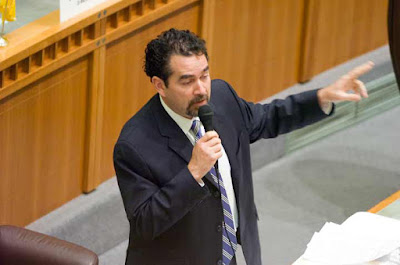
When Sen. Eric Griego, above, D – Bernalillo County, rose to speak for an extended period, against the confirmation, Sen. Phil Griego, below, promptly took a nap. Sen. Cravens walked past Phil Griego, bumping his chair and awakening him. He then knelt down and they chatted.
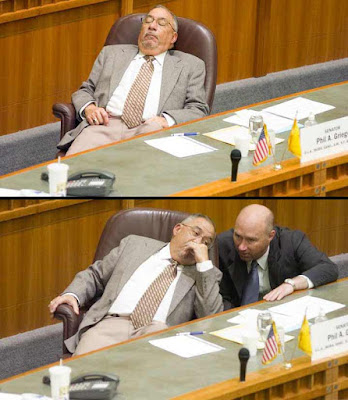
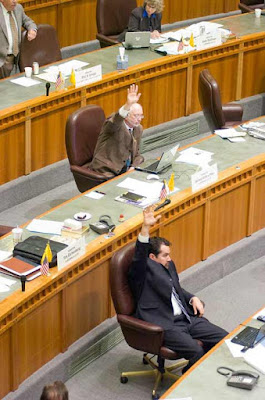
In a 31-5 vote, Koch was reconfirmed with Senators Feldman, Eric Griego, Stephen Fischmann, D - Dona Ana and Sierra Counties, Cisco McSorley, D - Bernalillo County, and Ortiz y Pino, voting against.
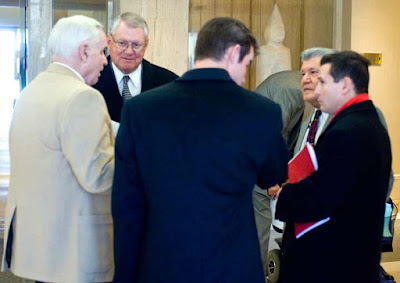
After the floor session, the UNM group: Koch, UNM President Schmidly, Kevin Grant Stevenson, former House Speaker and current Regent President Raymond Sanchez and Director, Government Affairs: Government and Community Relations Office Marc Saavedra, met in the lobby. Saavedra is Representative Kiki Saavedra's son, and is UNM's government relations head lobbyist.
Stevenson, as ASUNM president agreed to lock into an increase of $250,000 in student fees a year to athletics for three years.

My Take
 Regent
Regent Koch was chairman of the New Mexico Democratic Party in 2002 and a major political fundraiser and long time supporter of Richardson who won the gubernatorial election that year. He is president of the Daniels Insurance Company Inc., founded by the late former State Representative
Jack Daniels D - Lea County from 1967 - 1970, who was Lt. Gov Diane Denish’s father.
Koch was the original author of the Inspection of Records Act, according to his UNM regent’s biography.
In a comment by then City Councillor Michael Cadigan, to my February 26, 2009 posting, Time to go?, wrote:
I was at the meeting yesterday. I suppose the hostility in the room should have foretold this result, but I am pleasantly shocked by the virtual unanimity. I hope the UNM leadership gets the message that we have all had enough of nepotism, overpaid consultants, overpaid administrators, bloated middle management, financial irregularities and bad stuff in general.
Koch is representative of the Jeffersonian adage: "To the victors go the spoils."
Gov. Richardson gets to pick whom he wants for political positions and the Senate chose to grant him their approval even in the face of some pretty damning charges.

The Senate has only
rejected one of Gov. Richardson's political appointees in his eight years in office; Environmental Improvement Board's Neri Holguin's nomination was defeated 17-25.
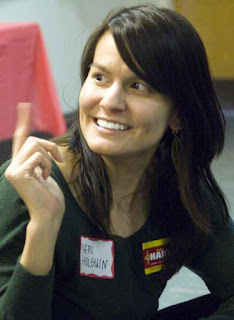
Holguin, right, is a Democratic operative and has directed several high profile campaigns. She shepherded Progressives Eric Griego and Tim Keller to Senate primary victories against incumbents James Taylor and Shannon Robinson two years ago. They had no general election opposition.
Holguin is currently managing Democratic candidates Ray Powell for Land Commissioner and Maggie Hart Stebbins for Bernalillo County Commissioner.
The rejection seemed to be as much a result of traditional Democrats sending a message to recently elected Progressives they were irritated with their tactics of attacking incumbents through the use of non profit "informational" mailers exposing legislators voting records and support or the lack thereof of Progressives issues.
Personal note:
Holguin approached me a couple of years ago looking to purchase photographs of Taylor and Robinson to be used in negative campaign ads. I told her I didn't do that and she, unlike many others, honored my statement.
Her rejection reminded me of the story of the Heisman trophy winner's experience in his first professional football game. He was hit by a couple of veteran players in a bone jarring tackle. As the massive defensive men got up one of them threw an elbow at the runners helmet and said, "Welcome to the NFL rookie."
Newcomers Eric Greigo and Keller came into the Senate with aggressive political agendas. Keller introduced more pieces of legislation on the first day of this session than any other Senator. By tradition he was informed that he was picking up the lunch tab for his fellow Senators the next day.

Sen. Michael Sanchez holds a firm grip on his leadership position by controlling what items and their order of appearance are on the agenda.
His power is apparent as Senators from both sides of the aisle lobby him to move their particular item forward.
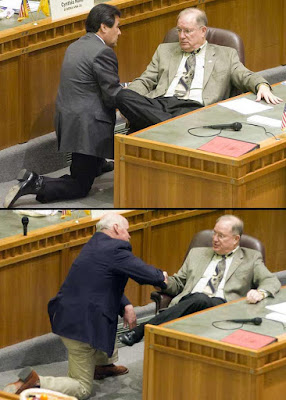
Sen. Pete Campos D - Guadalupe, Mora, San Miguel, Santa Fe, and Torrance Counties, top panel, and Senator Clinton Harden R - Colfax, Curry, Harding, Quay, San Miguel, Taos, and Union Counties, lower panel, kneel before Sanchez to discuss matters.

Sanchez doesn’t always get such reverence, as he talks with Sen. John Pinto, left, D - McKinley and San Juan Counties, the senior most member of the Senate or when he walks across the aisle to speak with Sen. Rod Adair, R- Chaves and Lincoln Counties.
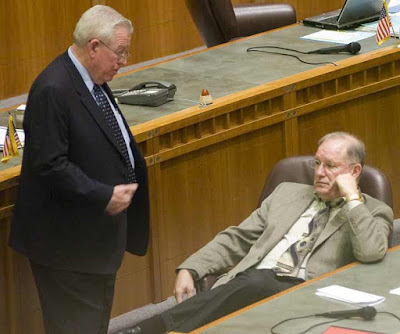
And to some, like Chairman of Senate Finance Committee Sen. John Arthur Smith, D - Hidalgo, Luna and Sierra Counties, he shows no such respect.
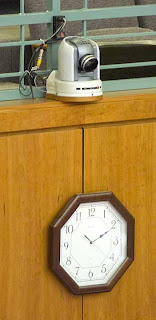
Sanchez introduced
Senate Resolution 1, Amending the Senate Rules to Expand the Number of Cameras Used to Webcast Senate Proceedings, from the single stationary camera, left, at the rear of the chamber.
However, it has moved very slowly through the committee process and was called up over the weekend, but laid on the table because Sen. Eric Griego who was carrying
Senate Resolution 4, amending the Senate rules to require webcasting of committee meetings, that stalled in the Rules Committee where it never received a hearing, wanted to try to amend SR 1 on the floor to include webcasting committees.
Ultimately, SR 1 remained on the Leaders table, despite Sanchez'
statement that the issue wasn't dead and could come up again, and after
gentle prodding from
Blogger Heath Haussamen.
The issue of government webcasting has
become a big deal.
My efforts fell way short of my own expectations as I encountered technical difficulties, then figuring out some new equipment. Finally, I was felled by the sickness of the Roundhouse and was laid up for full two weeks with a bad cold.
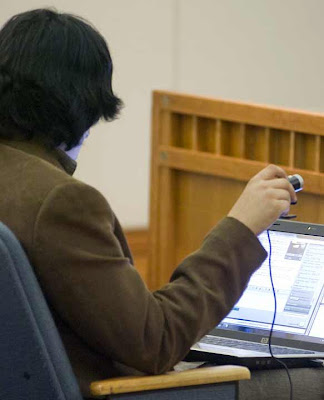
Upon passing Sanchez’ resolution to expand the number of cameras on the floor, at Senate Rules, Chair Sen. Lopez told New Mexico Independent’s Matt Reichbach, above, who was live blogging and videostreaming, that the Senate Rules Committee had been webcast for two years now, asked why wasn’t the Senate Judiciary Committee covered.
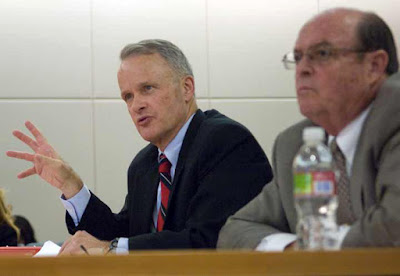
It’s ironic that Lopez hadn’t noticed the extensive coverage of Judiciary when they held hearings taking testimony from former investment officer at the Educational Retirement Board, Frank Foy, above right, and his attorney, Victor Marshall, about the fraud lawsuit they brought involving the State Investment Council and the ERA.
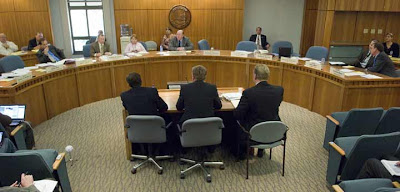
Lopez did not attend those Senate Judiciary Committee meetings January 21 and 25, 2010.

Land Commissioner Patrick Lyons, center, and Attorneys for the SIC testify before the Senate Judiciary Committee.

House Minority Whip Keith Gardner, left, R - Chaves, Eddy, Lea and Roosevelt Counties, with House Minority Floor Leader Tom Taylor R - San Juan County, spoke at the GOP House caucus press availability that webcasting had an effect on the use of leadership power.
Leadership power is the ability to control an agenda, to set priorities; it denotes making decisions that may disappoint some of those who are led.
Leaders are hesitant to have their decision making laid bare to total public scrutiny.

About That Fly on the Wall
There is a journalistic philosophy about reporting the news, especially about policy. The current concept is that a reporter is supposed to be a fly on the wall documenting what is said from the various sides of the particular issue at hand.
It is actually only a myth.
The problem with the fly on the wall technique is that those being reported upon or recorded often times spin information the way they want the story to come out.
I have even advised people that when the media asks a question, you control the answer. My advice is specific though to being asked the really dumb question that totally misses the point. However, often times, especially politicians and high level bureaucrats may attempt to obfuscate answers they perceive as potentially damaging to their reputation or plan. Media confrontation is sometime necessary.
During the public comments section of the UNM Regents confirmation my blogging buddy and fellow camera operator, Ched MacQuigg, spoke out against the reappointment of Jamie Koch.
Madam Chair, members of the committee, my name Ched MacQuigg. I believe it is fair to say that there is a feeling in this community, or this state, that there are two kinds of people; common people and then the people of power and privilege and that you really don’t care much about what we think. And I will offer as an illustration of that belief, Mr. Koch himself, who when the Journal asked him about the fact that he had lost this vote of confidence by 70-1; he said he didn’t care, that it ran off his back like water off the back of a duck. That statement alone disqualifies this man to represent the staff or anybody else.

Koch rolled his eyes as MacQuigg continued:
The people feel like the people of power and privilege are using this state government as a plum tree to pay off political cronies and loyal hangers-on; and we don’t want this man to get this plum. And yet I’ve been told that it’s a done deal as well. I heard a Senator say this morning he intended to vote in favor of this confirmation before the testimony even started.
Do you care about the feelings of the people at all; do our wishes care? You have vote after vote, these votes of no confidence; we say we don’t want these people and you’re just going to plow along with these nominations any way. It’s like you really don’t care what we say.
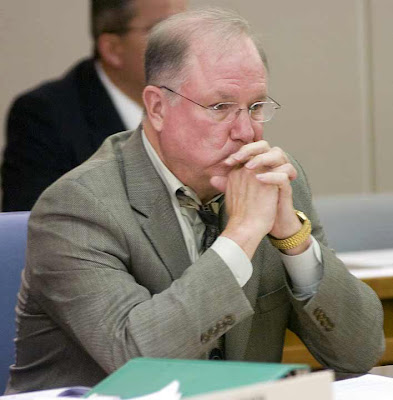
State Senate Majority Leader Michael Sanchez, above, said in response to MacQuigg:
Just real quick. This gentleman’s comments about my preconceived vote I minimizes your ability to communicate through e-mail. I have gotten hundreds of emails from these same people. Nothing they’ve said here today is different from what they’ve sent on emails. So don’t minimize the ability of people to communicate. Do we care about what people think? Absolutely, that’s why we’re here. You may disagree with us and we may disagree with you, but don’t think we aren’t up here listening to the people of the State of New Mexico. This is a group of people that has an opinion. There are other people who can’t be here today who I got emails from who have a different opinion than you. So don’t minimize their ability to communicate with us just because you’re capable of being up here today. Other people are not capable of being up here today.
But nothing that has been said here today changes my opinion from all of the things I’ve read, all of the things I’ve heard, and all of the things I’ve seen.
So, just keep that in mind when you want to criticize legislators. I would imagine that if someone was preconceived to vote no, you would say before the testimony, Oh, that’s great, right on.
MacQuigg: Yes sir.
Sen. M. Sanchez: Good. Well that’s the difference.
MacQuigg: You would be wrong.
Chair Sen. Lopez: Alright, please.
Sen. M. Sanchez: I just want people to know, we’ve gotten the message, we’re listening to people, We care about the University of New Mexico and their students; especially its students. They, to me, are the most important thing about our educational system.
Thank you. Thank you, sir.
KRQE's Anchor/Capitol Reporter Michael Herzenberg, asked me if MacQuigg worked for me.
No, he works with me as we document the legislative process.
Herzenberg said he had never seen a “journalist” or someone step out from behind a camera and become involved in the public debate.
I asked him what part of the First Amendment did he not understand?
He said it was a matter of journalistic standards as taught in Journalism 101.
I told him MacQuigg hadn’t taken Journalism 101.
Herzenberg said he hadn’t taken Journalism 101 either, but had learned through his years that “you” don’t become involved in the story you are covering.
To quote Governor Bill Richardson, who recently wrote on his own
blog, in a Valentines Day message to the legislature, (post since removed), “
Bovine Manure!”
The First Amendment is 45 words strung together with commas, semi colons and a period.
Congress shall make no law respecting an establishment of religion, or prohibiting the free exercise thereof; or abridging the freedom of speech, or of the press; or the right of the people peaceably to assemble, and to petition the Government for a redress of grievances.
It is not six separate and unrelated sentences. It is not a menu where you only get to pick one item to work from, it’s a smorgasbord, you can mix and match the articulated rights anyway one wants.
MacQuigg was distressed by Snachez’ prejudicial comment. He exercised multiple levels of the First Amendment: free speech, free press, right to associate and right to petition government for a redress of grievances.

Herzenberg, center, then interviewed Koch for his news story.
KRQE’s Larry Barker
reported about four governor appointed workers given high paying jobs after Richardson’s hiring freeze.
The four employees are:
India Hatch who served as the Interim Director of the Gaming Control Board, was then named temporary Executive Director of the New Mexico Film Museum and then back to the Gaming Control Board.
Revenue Department Director of Policy Administration S.U. Mahesh at Taxation and Revenue.
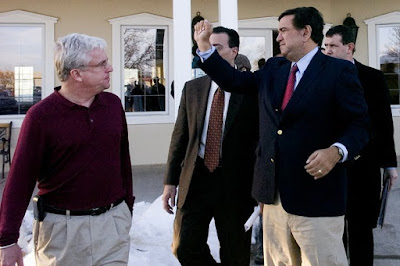
Gov. Bill Richardson’s once Director of Communications Pahl Shipley is now the Head of Publicity and Media Relations for the New Mexico Film Commission. Shipley, left with Richardson after the governor's January 2007 trip to Darfur to broker a cease fire in Sudan.
Director of the New Mexico Film Museum Sharon Maloof who was paid more than any other Director in the state’s Museum system. The Film Museum has no exhibits, displays or archives. It is a division of the New Mexico Department of Cultural Affairs.
Maloof 's lack of experience or expertise in curating a museum has been questioned along with her $88,000 a year salary. Her salary has since been reduced to $55,000.
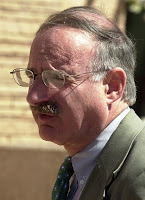
Barker, right, worked for Pahl Shipley when both were at KOAT TV; Barker was the investigative reporter, and Shipley as new director. Sources from within the KOAT newsroom report there was open animosity between the men.
Barker left KOAT and went immediately on the air at KRQE.
Barker didn’t mention the past relationship when he made the report.
Richardson refused to make a comment for Barker’s report. “Instead a spokesman told News 13 the governor feels he's going to be "screwed" on this story and doesn't want anything to do with it,” Barker reported.
Dan Boyd of the Journal
got a response.

Herzenberg, left,
offered Gov. Richardson an opportunity to comment on Larry Barker’s report about the four governor-appointed workers during a news conference on Tuesday. Richardson said he thought the report was biased, that he didn’t get his side out and the subjects of the report were hard working employees.
Herzenberg confronted Richardson asking what was biased about the report. Richardson said he had answered the question and moved on.
I would submit that Herzenberg's asking what was biased raised to the same level as MacQuigg making his statement. He wasn't being a fly on the wall.
Further, as sutble as it may be, KRQE has it own agenda when it come to reporting the news, especially towards the Catholic church in comparison with other religious groups. KRQE is not the only television station to express an agenda driven bias, KOB seems overly intent on following APD crime. These are not complaints, simply observations of the existence of such bias.
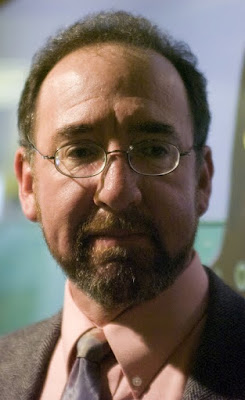
Herzenberg was not the only one taken aback by MacQuigg’s comment, Rules Committee Democratic Analyst Matthew Baca, above, was also aghast, saying that it was improper for someone running a camera to speak. Baca's non-legislative job is at UNM.
MacQuigg was running a tape camera of the Koch hearing when he ran out of tape. We had been in House Rules Committee room earlier and left some of our equipment there. Instead of going to get extra tape, MacQuigg chose to stay because he did not want to lose the opportunity to speak. When it came time for him to speak, MacQuigg spoke from the audience.
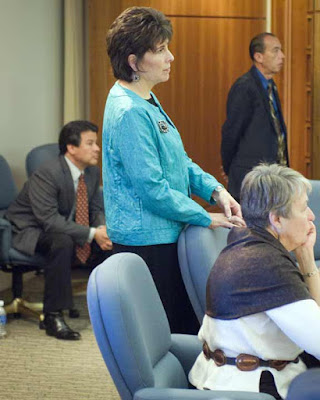
The Assistant Senate Sgt. At Arms David Ortiz, above right, announced that we would no longer be allowed to set up cameras behind members; a location that provided a view of the witness table and most members of the committee.

Ortiz said that he wasn’t going to allow citizens who were videoing and speaking to an agenda. It means Ortiz is defining the press.
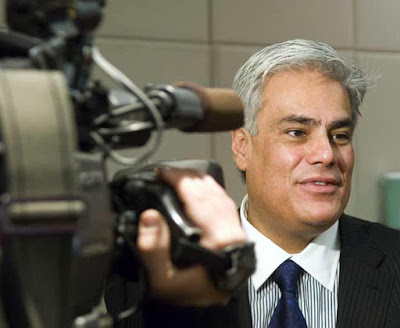
A year ago, House Majority Leader Ken Martinez, above, Cibola, McKinley and San Juan Counties, spoke during a Rules Committee on webcasting about his
belief that a person video documenting a group’s legislative effort who also wanted to testify was given the option to video or speak, but not both.
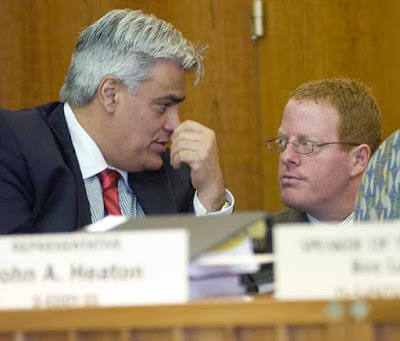
Martinez, seen here January 29, 2010, talking with Rep. Jeff Steinborn D - Dona Ana County who sponsored
House Resolution 2, to require webcasting of committee meetings and House Joint Memorial 15, to webcast and archive interim committee meetings.
Martinez moved to remove any language about archiving, replacing it with the statement, "the live stream shall not be archived."
Martinez also assured that the words, "the stream is not an official record of the house's proceedings," be added. His
argument is based on the fact that because legislative intent is not permitted as a consideration by the State's judicial system, only the letter of the law, there is no need for a record. His argument fails because there are other valid reasons to archive the proceedings, specifically for: educational, research, historic purposes, and for the convenience of citizens who can not attend the legislative sessions or watch live.
The real fear of legislators is that a record, in the form of a searchable archive would allow the public, constituents, and especially political adversaries could use their words in determining their political future.
House Minority Whip Gardner sponsored House Resolution 1, expanding the live streaming of House proceedings to include video and committee meetings in the chamber.
The
proposed rule change included, that the live stream shall not be archived, either of floor activity or, in the
final version, committee meetings.
The committee reports for Gardner's HR 1 and Steinborn's
HR 2 were accepted by the full House. Steinborn's House Joint Memorial 15 cleared the House and Senate Rules and the Public Affairs Committees but was not acted upon by the full Senate.

MacQuigg has assisted me in videoing the legislative process. I have a number of projects in various stages of development:
NM Senate Live is hosted by NMGOV.TV, which also hosts Rep. Janice Arnold-Jones R – Bernalillo County, efforts to webcast her committee assignments, Taxation and Revenue and Voters and Elections. Additionally I have provided live feeds through the New Mexico Independent.
Archived video for history, research, education, and for a potential documentary of ethics legislation.
This is in addition to our separate blogging and,
my archiving of still photographs.
Despite any technical difficulties I experienced or illness, my efforts with the assistance of MacQuigg, and the hosting support and technical help from Howard DeLa Cruz-Bancroft,
Out of the Box, LLC, and the willingness of
New Mexico Independent Editor Gwyneth Doland to attach my video stream to their live blogging, reaching a much larger audience; was a proof of concept to show that on a zero budget webcasting can be done effectively.
With my video webcasting on NM Senate Live, I followed the rules that I wrote last year for NMGOV.TV:
The simple webcastings protocols are:
1) It is nonpartisan,
2) The picture follows sound, meaning the legislator or witness viewed is the person recognized by committee chair or the Speaker of the House.
3) Nothing shown or recorded on the web cast will be used for negative political purposes or negative campaigns.
However, with my still camera I documented the actions and interactions of Senators, as regularly seen on this site.
The point is that a production controlled by the Legislative Council Services can establish similar rules to avoid making members of the body look bad. What they say is their responsibility. The prohibition of archiving is actually a form of governmental censorship.
The State Constitution's section 17, Freedom of speech and press; libel, says:
Every person may freely speak, write and publish his sentiments on all subjects, being responsible for the abuse of that right; and no law shall be passed to restrain or abridge the liberty of speech or of the press. In all criminal prosecutions for libels, the truth may be given in evidence to the jury; and if it shall appear to the jury that the matter charged as libelous is true and was published with good motives and for justifiable ends, the party shall be acquitted.
Legislators are attempting to make their official words disappear.
The government has funding available and there should be no technical impediments to having a state of the art broadcasting effort of all floor activities, interim committees, regular and conference committees webast. Archiving such webcasts are neither technically or economically prohibitive.
The only thing missing is the political will of a very few legislative leaders.
 This is the opening picture of my essay on Staten Island, looking east on Forest Ave. from Hoyt Ave.
This is the opening picture of my essay on Staten Island, looking east on Forest Ave. from Hoyt Ave.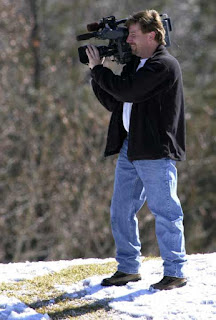 When it snows, the hill is worn bare by the tobogganors and makeshift sleds made from cardboard boxes. This KOB TV photographer shoots his kids in the park.
When it snows, the hill is worn bare by the tobogganors and makeshift sleds made from cardboard boxes. This KOB TV photographer shoots his kids in the park.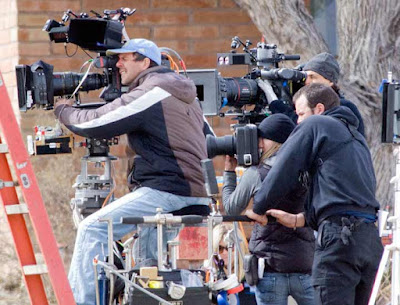 This is a story about State tax credits. Confused? So am I.
This is a story about State tax credits. Confused? So am I. They brought a bunch of trailers and parked in the local church’s parking lot.
They brought a bunch of trailers and parked in the local church’s parking lot.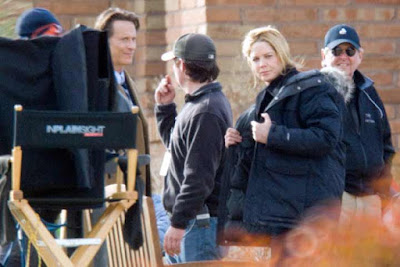 Actress Mary McCormack, above, plays US Marshal Mary Shannon with Actor Frederick Weller, below, playing her partner, US Marshal Marshall Mann.
Actress Mary McCormack, above, plays US Marshal Mary Shannon with Actor Frederick Weller, below, playing her partner, US Marshal Marshall Mann.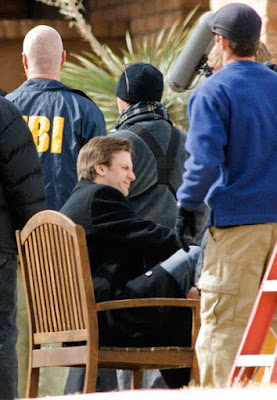 I got out my long lens that I use to photograph birds and sports and things that are a long ways away and took pictures of the filming process.
I got out my long lens that I use to photograph birds and sports and things that are a long ways away and took pictures of the filming process.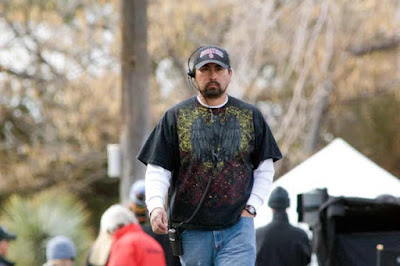 My activity attracted attention and this heavily tattooed man came over. For all his looks, he was a mild mannered messenger; “You can’t take pictures,” he said.
My activity attracted attention and this heavily tattooed man came over. For all his looks, he was a mild mannered messenger; “You can’t take pictures,” he said. Back in November, I stopped by the Gibson Medical Center Pharmacy to pick up a prescription.
Back in November, I stopped by the Gibson Medical Center Pharmacy to pick up a prescription.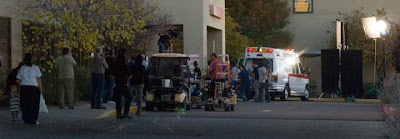 Breaking Bad, another locally filmed television show was shooting at the abandoned Emergency room and entryway.
Breaking Bad, another locally filmed television show was shooting at the abandoned Emergency room and entryway.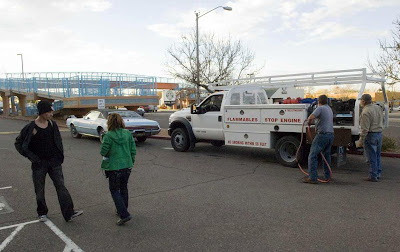 I had an interesting discussion with another production assistant who was making sure that people passing by didn’t inadvertently walk though a camera shot. She talked with actor Aaron Paul, left, who plays character Jesse Pinkman while a movie prop car was refueled.
I had an interesting discussion with another production assistant who was making sure that people passing by didn’t inadvertently walk though a camera shot. She talked with actor Aaron Paul, left, who plays character Jesse Pinkman while a movie prop car was refueled. Another Hollywood myth:
Another Hollywood myth: I’m not Felice Quinto, nor one of his aliases, from the 1960 Federico Fellini, directed movie, La Dolce Vita. Quinto, who passed away recently, was the model for the character of a 1950s tabloid photographer in Rome named Paparazzo. What Paparazzo did in the movie was stalk celebrities and royals in public places. Now Paparazzi is a name that is used with contempt and disdain for many photographers. However, it is not always accurately applied. Many celebrities crave the attention even while complaining about the photographers.
I’m not Felice Quinto, nor one of his aliases, from the 1960 Federico Fellini, directed movie, La Dolce Vita. Quinto, who passed away recently, was the model for the character of a 1950s tabloid photographer in Rome named Paparazzo. What Paparazzo did in the movie was stalk celebrities and royals in public places. Now Paparazzi is a name that is used with contempt and disdain for many photographers. However, it is not always accurately applied. Many celebrities crave the attention even while complaining about the photographers.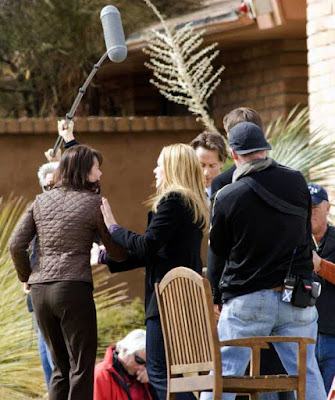 I could post Paparazzi like pictures of McCormack with her two cute small children, whom she talked about on the TV show, playing on the prop swing set, between takes, but I won’t. I'll just show her working.
I could post Paparazzi like pictures of McCormack with her two cute small children, whom she talked about on the TV show, playing on the prop swing set, between takes, but I won’t. I'll just show her working. This post is not about the stars particularly; my interest is political from the tax relief standpoint that the film industry is receiving from our state.
This post is not about the stars particularly; my interest is political from the tax relief standpoint that the film industry is receiving from our state.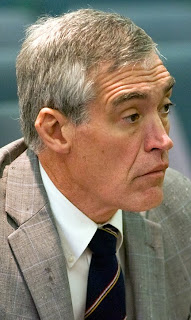 Rep. Dennis Kintigh, left, R - Chaves, Lincoln, and Otero Counties, has twice introduced legislation that would repeal the film production tax credit. In the 2009 Regular Session, it was HB 725, which died after the action was postponed indefinitely and in the 2009 Regular Session it was HB 52, which died without being heard in the House Labor and Human Resources Committee.
Rep. Dennis Kintigh, left, R - Chaves, Lincoln, and Otero Counties, has twice introduced legislation that would repeal the film production tax credit. In the 2009 Regular Session, it was HB 725, which died after the action was postponed indefinitely and in the 2009 Regular Session it was HB 52, which died without being heard in the House Labor and Human Resources Committee. Most of the set work is part time, but those employed infuse their income into the local economy and tax base. A production assistant carries two trays of coffee from the local Starbucks for her fellow workers.
Most of the set work is part time, but those employed infuse their income into the local economy and tax base. A production assistant carries two trays of coffee from the local Starbucks for her fellow workers. My Take
My Take I’ve taken pictures of movie making for years. In 1969, I photographed this crew across from the United Nations while they shot from the top of a rental moving van.
I’ve taken pictures of movie making for years. In 1969, I photographed this crew across from the United Nations while they shot from the top of a rental moving van.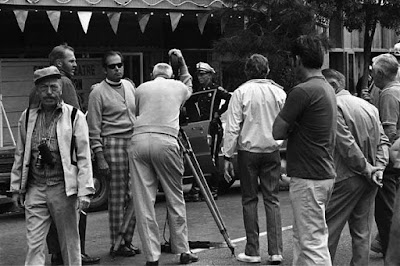 This is Gerd Oswald, left, directing the movie, Bunny O'Hare, downtown in 1971. The movie stared Academy Award winners Bette Davis and Ernest Borgnine.
This is Gerd Oswald, left, directing the movie, Bunny O'Hare, downtown in 1971. The movie stared Academy Award winners Bette Davis and Ernest Borgnine.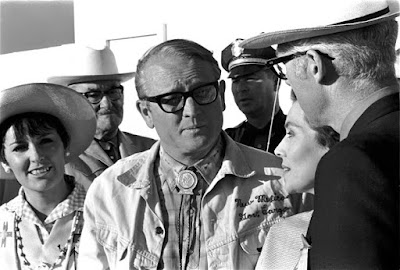 Gov. David Cargo, center, seen during the 1970 Republican Governors Conference in Santa Fe, played a State Trooper in the movie. He had concentrated on attracting movies to New Mexico through his newly established New Mexico Development Commission. A while back Cargo told me he still maintained his Screen Actors Guild membership.
Gov. David Cargo, center, seen during the 1970 Republican Governors Conference in Santa Fe, played a State Trooper in the movie. He had concentrated on attracting movies to New Mexico through his newly established New Mexico Development Commission. A while back Cargo told me he still maintained his Screen Actors Guild membership.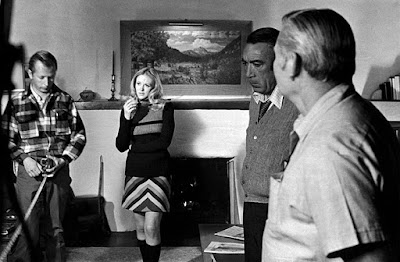 The same year, another Academy Award winner, Anthony Quinn, second from the right, played Mayor Thomas Jefferson Alcala with actress Skye Aubrey as Sabina Menard, on the set of, “The City,” a 2-hour pilot made for ABC TV. A series set in Albuquerque followed, renamed, “Man and the City.”
The same year, another Academy Award winner, Anthony Quinn, second from the right, played Mayor Thomas Jefferson Alcala with actress Skye Aubrey as Sabina Menard, on the set of, “The City,” a 2-hour pilot made for ABC TV. A series set in Albuquerque followed, renamed, “Man and the City.” The world has changed. Where giving publicity to the film industry was once openly welcomed, now production assistants attempt to assert control over their little world through confrontation and mild intimidation.
The world has changed. Where giving publicity to the film industry was once openly welcomed, now production assistants attempt to assert control over their little world through confrontation and mild intimidation.
